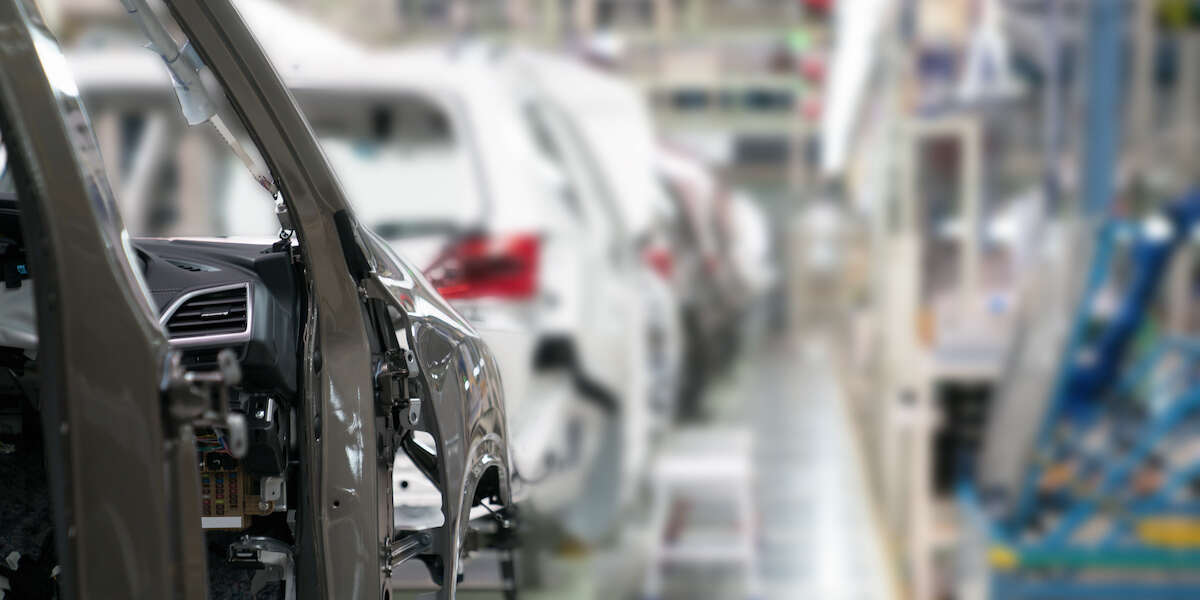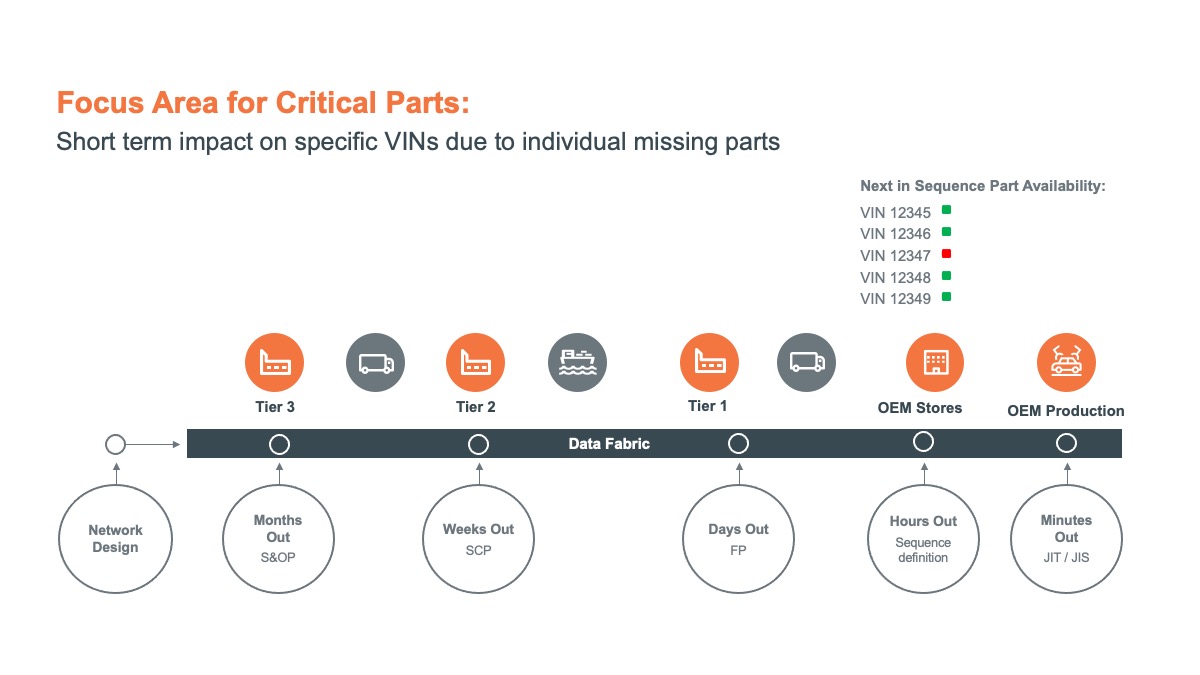 Monica McDonnell
Monica McDonnell
Critical Decisions for Critical Parts in Automotive Supply Chains
As automotive manufacturers pivot to recover their supply chains and build resilience against the background of perpetual disruption there is a class of parts which stands out. Read more.

As automotive manufacturers pivot to recover their supply chains and to build resilience against the background of perpetual uncertainty and disruption there is a class of parts which stands out. Critical Parts at those without which it becomes impossible for the vehicle to continue to move along the production line. Not having them often means shutting entire factories. When disruption to the supply of these parts arises fast, informed decisions are needed to mitigate the impact. Visibility is key to detecting problems early to maximising response time, but the right analytical tools are required answer the question “What if we can’t get the critical parts to the factory as per our original schedule?”
 BEWARE RIPPLE EFFECTS
BEWARE RIPPLE EFFECTS
Considering the vast number of parts required to assemble a modern vehicle, and the breadth and depth of supply chains bringing those parts to a single place, the factory, at a specific time, the build slot, the orchestration necessary to achieve this is amazing. In a typical factory a vehicle rolls off the production line every minute and each is customised to a unique specification. So, it’s easy to conceive that even a small disruption in supply for even one vehicle can introduce a significant ripple effect to the production of many more.
To protect against these risks, automotive manufacturers deploy one of two strategies:
- Prevent the parts from arriving at the factory late by holding inventory near the factory, by having a second source of supply or a pre-planned ability to expedite.
- Or ensure build of the vehicle can continue without the parts keeping the production line running. The specific vehicle can be rectified later, for example fitting a substitute part or leaving a gap where the part should go which can be fitted off the production line, or even at the dealer.
But, neither of these strategies works well for critical parts. Many of them will be customer specified and with thousands of iterations of customer specification it's simply not practical or cost effective to hold inventory of every variety. Or, if the part is buried deep in the vehicle or connects to lots of other parts it’s not practical, or even possible in some cases to fit those parts postproduction. Vehicle wiring harnesses are a good and topical example. They are custom built for each vehicle depending which infotainment, driver aids and other electrical options the customer has specified for that vehicle and are routed and buried deep within the structure of the vehicle making them extremely difficult to access once the vehicle is fully assembled.
THE RESEQUENCING HYDRA
Faced with these hurdles, many simply choose to delay the build of that specific vehicle by changing the planned build sequence. All the other planned vehicles behind it ‘move forward’ one slot in time, so all of their parts, critical and not, are need slightly earlier than originally planned. Pulling forward those parts may introduce other shortages, and it's easy to be caught in a vicious spiral of increasing, self-inflicted disruption.
Interestingly, re-sequencing in a way that resolves the current shortage without introducing more shortage problems down the line may mean shuffling the sequence of many more vehicles than required to solve the immediate problem.
Traditionally the decisions on how to manage a critical parts shortage have been made by teams of highly experienced supply chain operation professionals. But humans can only juggle so many moving parts, so these people rely relatively siloed information to make their decisions. With limited data they don’t have good understanding of the potential unintended consequences of that resolution action. Sometimes they are successful, resolving the current issue and sometimes the production line stops despite their best efforts. More often than not their best intentions set off that vicious spiral multiplying problems; a supply chain version of the Hydra, cut off one issue and seven more pop up!
IT COMES DOWN TO MATHS
The good news is that resolving all of this is actually just an extremely complicated, dynamic, fast moving maths problem. Visibility of the moving pieces at a very granular level provides all the information needed to solve the puzzle. Seeing accurate data on the parts for the specific vehicles, the parts for other vehicles, logistics constraints, production schedules, capacity and planned shift patterns in near real time provides the basis for better decision. With this data thousands of ‘what if’ re-sequencing scenarios can be run in the blink of an eye to identify the specific actions that best achieve the objective of keeping the production line running and minimising impact to the eco-system.
Changing the production sequence means running ‘what if’ scenarios not just for the specific vehicle affected, but for every vehicle impacted by that change in production sequence. This could easily run to thousands of vehicles and potentially millions of parts. Historically a solution that can operate at this speed, scale and level of granularity has simply not been available. But with current Teradata technologies it is absolutely possible today. We can connect all of the data threads from multiple disparate sources and weave them into an all-encompassing dynamic data fabric to support this level of real-time decision making.
GET BEYOND DEFENCE
Global automotive supply chains are extremely complex and fast moving and can no longer be managed end to end using spreadsheets and human intervention. Digital solutions employing AI and ML algorithms are the only viable way of managing this beast.These require investment, but from a cost perspective manufacturers simply cannot afford production facilities to be offline, and brands cannot afford to disappoint customers with late delivery. Beyond the ‘defensive’ business case there is an important benefit that shouldn’t be overlooked. Exactly the same granular data and analytics can be spun through 180 degrees to seek out opportunities to optimise operations, remove non-beneficial inventory, refine and simplify supply chain networks and support even better customised vehicle options. If implemented correctly our solution can now help manage global and localised disruptions reducing risk and improving operational efficiency.
As the old saying goes ‘never let a good crisis go to waste’. The pressing need to introduce a data and analytics solution for critical parts is a fantastic opportunity to improve overall efficiency.
To find out more, please get in touch.
알고 있어
테라데이트의 블로그를 구독하여 주간 통찰력을 얻을 수 있습니다
.jpg?origin=fd&width=100)